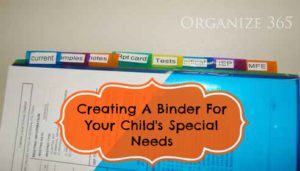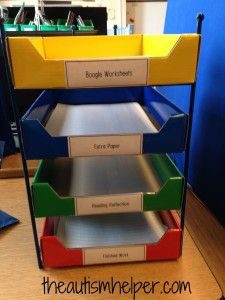Organising, Sequencing and Prioritizing an Autistic
The ability to organize, sequence and prioritize helps us to plan daily activities and manage our time effectively. However, some people with autism spectrum disorder (ASD) may find organizing, sequencing and prioritizing difficult. Here, we explain why this can be the case, and list some ways to help. People with an ASD may have deficits in what we call ‘cognitive function’, that is, the intellectual process by which we think, reason, understand ideas and remember things. So a person with an ASD may have difficulties with:
* processing information
* predicting the consequences of an action (if I do this, what will happen next?)
* understanding the concept of time
* ‘executive function’ (i.e. a person may be detail-focused and less able to see the whole picture).
One or all of these four examples can affect a person’s ability to organize, prioritize and sequence. For example, if you struggle to understand the concept of time, how do you plan what you will do over the course of a week? Here are some ways in which people with an ASD can organize and prioritize daily activities and tasks (we’ll call them ‘strategies’. At first, other people may need to have a lot of involvement introducing the strategies and helping a person with an ASD to get used to using them. You may use the strategies in more than one place, for example at home and at school. Therefore, it is important that everyone who is using them – be it family members, employers, teachers or friends – uses them consistently. Over time, some people with an ASD will be able to use the strategies independently – although others may always need support.
Suggested strategies
Many of us use certain strategies to help organize our day and prioritize tasks. For example, we might make a list or write things on a calendar. These strategies can also be effective for people with an autism spectrum disorder (ASD), especially if they’re used consistently by everyone who may support a person.
Visual supports
Visual supports – pictures, written lists, calendars and real objects – can all be good ways of helping people with an ASD to understand what is going to happen, when. For example, a person might have a daily timetable with pictures of a shower, clothes, breakfast, their school, dinner, a toothbrush, pajamas, and a bed to indicate what they will be doing, and in what order, that day. This can help people to plan their day and organize themselves.
Color coding
Colors can be used to indicate the importance or significance of tasks (and therefore help to prioritize tasks and work through them in a logical sequence). For example, work in a red tray or file could be urgent, work in a green tray or file could be pending, while work in a blue tray or file is not important or has no timescale attached to it. Colors can also help people to distinguish between paperwork, for example different household bills.
Dictaphones
Dictaphones can be a useful auditory reminder of tasks, work, events or deadlines.
Lists
Many of us use lists to remind ourselves of the tasks we need to do, and to help us prioritize. Lists (whether written or visual) can help people with an ASD in just the same way. Lists can also be a good way of registering achievements (by crossing something off when you’ve done it), and of reassuring yourself that you’re getting things done.

Electrical equipment
Mobile phones, computers, radios and televisions can be used to store important information, or to act as a reminder. Computer calendars can have important dates stored on them, or reminders about when to pay bills. Radios and televisions can be set to come on at a particular time as a reminder to do something, eg to go out to a social event. Instructions can be sent by text – text messages lend themselves to this especially well as you are forced to keep instructions brief and simple. A text message is also an unobtrusive way of contacting or supporting a person with an ASD – they won’t stand out from the crowd.
* Task boxes, envelopes and files
* Store work or belongings in set places, so that they aren’t misplaced or forgotten.
* Times of day, days of the week
It may be easiest to use times of day (morning, afternoon or evening) or days of the week to help plan and organize tasks, social activities and other events. For example, Saturday is shopping day, Wednesday is bills day, Thursday night is homework night.
Social stories™ and comic strip conversations
Social stories™ and comic strip conversations can be a really good way of illustrating the consequences of an action. As such, they can help people with an ASD to understand why it’s good to be organized: what might happen if we don’t meet deadlines or attend an activity at a particular time?
Teaching materials: time and sequence
You may find that teaching materials such as sequence cards, games, timers and clocks help some people on the autism spectrum to understand the concept of time and sequences. Materials like this can be adapted and used in different places, for example at home and at work.
 Practical application of strategies
Practical application of strategies
Here are some examples of how the strategies above can be used in different places.
At home
Household jobs can be allocated days, for example:
Monday – wash clothes
Tuesday
Wednesday – food shopping in the evening
Thursday
Friday – sort and pay bills
Saturday
Sunday – sort recycling and put out for collection
Every day – wash the dishes, dry them and put them away
These daily tasks could be a written list, or illustrated on a visual calendar. If there are several tasks to be done every day, they could be allocated to different family members and color coded to indicate which ones should be prioritized.
Managing money
We all need to learn how to manage our money, to budget, control spending and pay bills. Many adults with an ASD will manage their own money or bills, to varying extents, while children may have pocket money. It can help to set out very specific guidelines about managing money and the consequences of spending.
Shopping
Shopping for both clothes and food can be difficult for some people on the autism spectrum because of the crowds and noise. For those with access to a computer, shopping online could be an answer. Alternatively, try to encourage the habit of visiting the shops with a clear list of items needed, and going at a time when the shops are quieter or less busy to reduce anxiety or stress.
Education
Homework, assignments and deadlines can cause great anxiety for some people. Others will not register their significance. It is therefore important that students on the autism spectrum are helped by the right approach to support their study. The following strategies will help:
* clear monitoring
* regular meetings with teaching staff
* color coding of files.
Some people may need help in understanding the end goal of what to them may seem continuous work and deadlines. Processing of instructions can be difficult, so it may be useful to use communication books and dictaphones to reduce the pressure on the student of trying to remember what they are supposed to be doing.
 Work
Work
Strategies to employ in the work environment include:
* using files and color to identify and clarify the importance and deadlines for particular pieces of work.
* making a clear to do list at the beginning of the day. You can then cover up or mark off work which has been completed.
* arranging regular meetings with your line manager to ensure work is understood and work is progressing.
* using the computer programs available to help organize work. For example color coding emails relating to importance of response.
* using the calendar as a reminder for meetings or deadlines.
Family occasions/ social activities
Calendars are handy to record events – birthdays, parties, weddings, allocate days for particular friends or social activities like Friday – cinema night.
Further reading
Attwood, T. (2000). Should children with an autism spectrum disorder be exempted from doing homework? www.tonyattwood.com.au
Holliday Willey, L. (1999). ‘Organising your home life’ in Pretending to be normal – living with Asperger’s syndrome. London: Jessica Kingsley Publishers.
Stevens, V.B. (2012) Organization: prepping your sixth grader for success. Autism Asperger’s Digest, Sept-Oct, pp. 36-38. (Available from the NAS Information Centre).
Winner M. G. (2007) Homework and beyond! Teaching organizational skills to individuals with ASD. Autism Asperger’s Digest, July-August, pp. 40-45. (Available from the NAS Information Centre).
